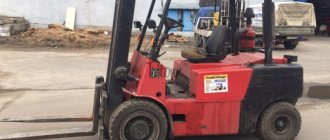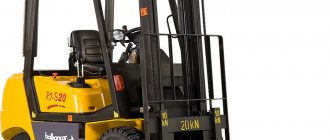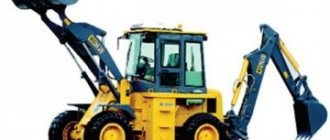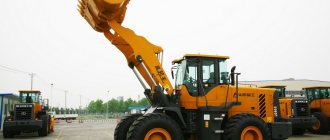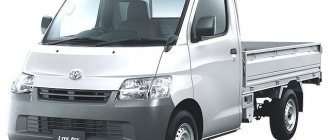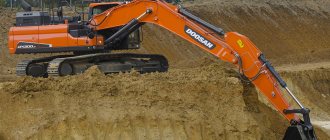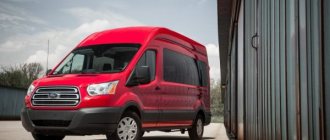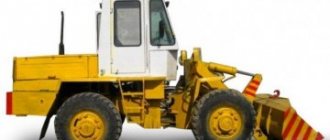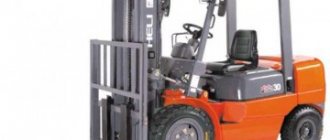How much oil do you need to fill in a Balkankar loader? What kind of oil to pour into the loader.
How much and what kind of oil should be poured into a Balkankar loader?
For diesel engines D2500 and D3900, motor oils of type M10G2K are provided (according to the operating instructions) or any diesel oil with a viscosity of 10W40 or 10W30. For the D243 engine (installed on the DV 1792M loader) – M10DM for turbocharged engines.
To change Balkankar oil you will need the following quantities:
Engine oil volume D2500 – 7.5 liters (DV 1621, DV 1661)
Engine oil volume D3900 – 8.5 liters (DV 1784, DV 1786, DV 1788, DV 1792, DV 1794, DV 1798, Dimex D35 and others)
Engine oil volume D243 – 12 liters (DV 1792M)
For your convenience, I will attach photographs of the engines so that you can clearly compare.
How much oil should I pour into the gearbox?
There were two main types of gearboxes installed from the factory - a hydrodynamic transmission (hydrodynamic transmission) and, on earlier versions of a manual transmission forklift, a conventional manual transmission. Automatic boxes are divided into two types: GDP 6844 (old type) and GDP 6855/6860 (new type)
To change the Balkankar automatic transmission oil we will need:
For HDD 6844/6855/6860/6870/6865, 12 liters of oil are used (together with the torque converter) TYPE “A” or ATF Dexron II for the old and new types the same, without a fluid coupling about 9 liters.
How much coolant is included?
According to the manual, you should add water or antifreeze, but practice shows that it is quite possible to use antifreeze. Balkankar produced engines with cast iron and steel blocks; they are not fussy about coolant. It is best to use TOSOL or green antifreeze G11.
Up to 2 tons (DV 1621, DV 161) - from 15 to 18 liters of coolant.
More than 2 tons (DV 1784-1798) – 20 liters (in practice it includes less)
For loaders DV 1784, DV 1786, DV 1788, DV 1792, DV 1794, DV 1798, the quantity set is 65 liters of I20A or other gear oil H32, H46. For small forklifts DV 1621, DV 1661 and other modifications - liters of the same transmission.
Oil for Balkancar loader axle
For forklifts up to two tons (DV 1621, DV 1630, DV 1636, DV 1661) use 5 liters of gear oil TAD 17A or according to API GL4, GL5 80W90 approval; for forklifts over two tons (DV 1784-1798) the same amount is used, exactly 5 liters.
Brake fluid quantity
According to the technical literature, all Balkankar loaders use 0.5 liters of brake fluid, although in reality a little more is included, it’s worth taking 1 liter, it’s not that expensive. You can use the ROSA or NEVA brands.
General technical specifications
When describing the technical characteristics of the Balkankar DV 1792 loader, we must remember that this model of diesel machine later underwent a number of changes, and the parameters became different. And this car has the following indicators:
- weight – 5.45 tons;
- length – 2.856 meters;
- from the left sidewall to the right sidewall - 1.7 meters;
- lifts the load at a speed of 38 mm/sec.;
- height with the fork mast lowered – 2.24 meters;
- lifts the forks to a height of 3.3 – 4.5 meters;
- unfolds with a radius of 2.7 meters;
- lifts a load weighing 3500 kg;
- has a diesel engine;
- with a load it moves at a speed of 22 km/h.
- distance between wheels – 176 cm;
- There is a driver's seat, a frame cabin, open type.
What kind of oil to pour into the Balkankar loader box
Servicing front loaders includes not only checking the functionality of the main components and troubleshooting them, but also changing the oil. To perform these works, it is important to immediately purchase consumables of the appropriate type. Spare parts for Hyundai loaders and oil for special equipment mechanisms should definitely be selected according to their intended purpose and taking into account the manufacturer’s recommendations. Duplicates or materials that are not suitable for a specific model or operating conditions simply will not ensure efficient operation of the machines.
Features of the procedure
One of the mandatory maintenance measures for special equipment is replacing the lubricant. This procedure should be performed regularly, since this liquid ensures the uninterrupted operation of components and parts.
Important: the main function of lubrication is to reduce the effect of friction in the units. This eliminates the risk of premature wear of special equipment mechanisms.
In front loaders, oil changes are required in four working units:
Important: each unit requires certain types of lubricant. In addition, the replacement procedure is performed at specified intervals in each specific case.
When choosing a fluid, you should take into account not only its purpose, but also several additional parameters: the degree of wear of the units, the type of lubricant recommended by the direct manufacturer of the special vehicle of a certain brand.
Principle of oil classification
The correct choice of technical fluid for front loaders depends on operating conditions. The seasonality of the lubricant (it is worth buying it taking into account the time of year) and composition have a big influence. Based on the last factor, the following types of technical fluids can be distinguished:
The main differences are in viscosity and chemical composition. Thus, mineral liquids are viscous and are optimally suited for use in the hot season. For winter, especially when working outdoors, preference should be given to synthetic and semi-synthetic compounds.
Features of choosing engine lubricant
In addition to the operating conditions in which special equipment operates, the type of power unit should be taken into account. Motor oils for gasoline and diesel engines differ in composition and properties. When choosing, pay attention to the labeling of the liquid.
For gasoline power units, the recommended compositions are 10W-40, SAE 10W-50, etc. Diesel ones are filled with 15W-20 (40). The most popular are synthetic and semi-synthetic oils of the following brands: Caterpillar, Shell, Mobile, etc.
Types of Motor Oil Bases
Synthetic motor oil
Synthetic motor oil for forklifts is designated “Fully Synthetic” on the packaging and is made from a synthetic base. That is, even at the stage of creating the oil base, it allows you to set the required properties, as well as ensure a high content of modifying additives. Oils of this type provide optimal protection and “cleaning” properties, are less susceptible to an increase in viscosity at low temperatures, and are able to withstand maximum operating temperatures.
Front loader: what oil to pour into the loader
Mandatory maintenance of a front loader includes regular replacement of lubricating fluids. This is necessary to ensure uninterrupted operation of the power and operating equipment of the loader. Which front loader units require regular oil changes? What frequency must be observed? How not to make a mistake in choosing the right oil? Knowing the answer to all these questions, the front loader owner reduces repair costs and increases the longevity of the equipment.
Which loader components require regular oil changes?
Almost every working part of a front loader needs lubrication. The lack of lubrication in one of the elements creates friction between the parts and provokes their destruction. Before you figure out what kind of oil to pour into your loader, you must first find out what equipment needs it.
Unlike a conventional vehicle, to improve the functioning of a front loader, the oil must be periodically changed in three working elements:
For each of these elements, not only different oils are provided, but also changes occur at different intervals. Also, when choosing suitable lubricants, the degree of wear of the units and the type of oils recommended by the manufacturer are taken into account.
Classification of oils used for front loaders
The correct choice of oils depends on several conditions relating not only to the characteristics of the forklift itself, but also to the conditions in which it is operated. The seasonality of the work performed by the loader is also important. One type of oil is suitable for working in winter conditions, and another type is suitable for hot summer conditions. For loading equipment, it is customary to use oils classified similarly to other types of transport and equipment:
The characteristics of these oils differ in their chemical composition and viscosity. For example, mineral oils are characterized by a more viscous state, so it is recommended to use them at high air temperatures. To operate equipment in winter in open areas, it is more appropriate to use semi-synthetic and synthetic oils.
The specification of the recommended oil is indicated in the instructions for each model of special equipment. But replacement with alternative options is possible.
Engine oil for front loaders
In addition to assessing the operating conditions, you will also need to take into account the fuel on which the front loader engine runs. Motor oil for diesel and gasoline (combined with gas) engines, different in composition and properties. For gasoline engines, oils marked 10W-40, SAE10W-40, SAE 10W-50 and others are recommended. It is customary to pour 15W-40, 30, 20 into diesel engines. The most popular among users of loading equipment are synthetic and semi-synthetic oils from Shell, Conoco, Caterpillar, Mobile.
The engine oil should be changed at least every 200-250 operating hours. If used infrequently, replacement occurs once a year.
Forklift Transmission Oil
Front loaders are equipped with two transmission systems. These are manual transmission and automatic (automatic transmission). This determines what oil needs to be filled when changing. An oil change in a manual transmission will be needed no more than after 2000 operating hours. Special transmission oil is used, which is intended for pouring into boxes, axles and gearboxes. The marking of such oils is SAE80W-90, 85W-140, for example Shell Spirax S3 AM 80W-90.
An automatic transmission is more demanding in terms of maintenance and oil changes. The frequency should not exceed 400 operating hours. If motor, hydraulic or regular transmission oil is accidentally poured into the automatic transmission, this will lead to serious malfunctions. There are special hydraulic transmission oils for automatic transmissions, or they are also called transmission fluids for automatic transmissions. Conoco Dexron VI ATF is suitable for use in automatic transmissions of front loaders.
What kind of oil to pour into the loader hydraulics
For efficient operation of a loader's hydraulic system, oils are required that will create high pressure in the system. Stable operation of hydraulics is ensured by a special oil composition, which includes additives:
Hydraulic oil must have a long life in its original condition, increase the service life of the hydraulic system and prevent destructive effects in the form of corrosion.
Hydraulic oils must meet the requirements of GOST or ISO.
Video
Product catalog Balkancar
Spare parts for Bulgarian forklifts DV1784/1788/1792/1794 with D3900 engine, spare parts for Bulgarian forklifts EB687, spare parts for Balkancar forklifts DV1621/1661 D2500
Catalog of spare parts for BALKANCAR forklifts
| Spare parts for engine D3900 DV1792 | |||
| engine shock absorber | bendix | flywheel crown | fan |
| main liners R1 | main liners R2 | main liners R3 | main liners STD |
| water pump | connecting rod bushing | valve lid | inlet valve |
| 1 | |||
| exhaust valve | piston rings 5 | piston rings 4 | gasket set |
| connecting rod bearings R3 | connecting rod bearings R2 | connecting rod bearings R1 | connecting rod bearings STD |
| radiator hose | radiator hose | posheng | cylinder head gasket |
| QC gasket | radiator | water radiator | generator belt |
| injection pump | TPN 2 | TPN 4 | muffler pipe |
| HP fuel pipes | LP fuel pipes | half rings | Air filter |
| filter settling tank | fuel filter assembly | spacer | nozzle |
| connecting rod | pipe branch | filter element | |
| Spare parts for engine D2500 DV1661 | |||
| shock absorber | fan | main liners STD | main liners R3 |
| main liners R1 | main liners R2 | connecting rod bearings R1 | connecting rod bearings R2 |
| connecting rod bearings R3 | connecting rod bearings STD | water pump | hose |
| valve sleeve | connecting rod bushing | sleeve | inlet valve |
| exhaust valve | crankshaft | piston rings | gasket set |
| oil pump | injection pump | radiator hose | radiator hose |
| piston | cylinder head gasket | QC gasket | spray |
| TPN 2 | TPN 4 | muffling cable | muffler pipe |
| HP fuel pipes | fuel pipes LP | nozzle | connecting rod |
| Spare parts for HDD loaders DV1784/88/92 DV1661 | |||
| sleeve | GDP assembly | friction disc | metal disk |
| disk is thick | GDP turbine wheel | freewheel mechanism | guide mechanism |
| Working wheel | HDP pump | O ring | pump axis |
| needle bearing | HDS piston | Distributor RKhTD10 | GDP repair kit |
| gasket gasket set | GDS cable | Stuffing box | HDP filter |
| Spare parts for Balkancar loader steering axle | |||
| rudder bipod shaft | retaining ring | fist rotating p | steering knuckle l |
| steering axle assembly 1792 | king pin 1792 | steering knuckle axis 1661 | eye pin |
| bolt | axis | bearing | silent block |
| bearing | thrust bearing | eye | gearbox EB687 |
| tie rod end | steering tip l | steering cylinder | rudder bipod |
| Traction steering | power steering XU85 | ||
| Spare parts for the brake system of Balkankar loaders | |||
| GSC 19.05 DV 1661 | GSC 25 DV1788/92 EB687 | flange | hand brake pad |
| brake pad 1792 | brake cable | brake slave cylinder | KSSD 35A DV1792 |
| Spare parts for the mast of Bulgarian forklifts | |||
| bushing45x55 | bushing 65x75 | bushing 70x80 | retaining ring 70 |
| retaining ring 65 | cover 55x63 | cover 80x88 | bearing race 80x88 |
| bearing 80x88 | small roller | chain 1792 33 | washer |
| Spare parts for electrical equipment of BALKANKAR forklifts | |||
| temperature sensor | fuel level sensor | egnition lock | sound signal |
| switching magnet | engine hours | reverser | relay pp380 |
| solenoid relay | starter M114 | starter with gearbox | thermostarter |
| temperature indicator | fuel level indicator | headlight | dashboard |
| Spare parts for hydraulics of BALKANCAR loaders | |||
| toothed bushing | pump A14X | pump A25X | pump A072X |
| pump A72X-1 | distributor РХ 80 | pipe branch | hydraulic filter 1661 |
| hydraulic filter 1792 | tilt cylinder 1792 | hose | |
| Spare parts for the drive axle of Balkancar trucks | |||
| ,bolt 1792 | bridge nut 1792 | final drive assembly | differential 1792 |
| universal joint | cross | wheel bearing | cardan flange |
| washer 1792 | washer DV1792 | gear pair | gear 1792 |
| Wheels for Bulgarian loaders | |||
| wheel bolt F22 | wheel bolt F14 | wheel nut F14 | wheel nut F22 |
| disk 6.00x9 | rim 6.50x10 | disk 7.00x12 | disk 8.15x15 |
| Spare parts for Balkancar loaders | ||
| hood 1792 | steering wheel 1792 | sitting |
YOU CAN ORDER SPARE PARTS FOR BALKANKAR LOADS BY PHONE!
Call and order spare parts for KOMATSU loaders.
Source
Features of choosing transmission oil
Front loaders are equipped with this unit of one of two types: mechanical or automatic. The type of box directly determines the choice of lubricant.
Thus, special transmission compounds are added to a manual transmission, which can be poured into axles, gearboxes, and gearboxes. This is SAE 85W-140 or 80W-90. Replacement is carried out every 2,000 operating hours.
Automatic transmissions are more demanding on the quality of the lubricant and care measures for the transmission unit. Replacement frequency: 400 hours worked, at least. However, you cannot use traditional fluid for a conventional transmission. This approach will cause a quick breakdown.
Repair of box Balkankar 6860, 6855, 6844 Balkankar
Spare parts for loaders. Forklift repair in Rostov-on-Don
+7 spare parts repair area
The amount is indicated subject to the cash payment system, by bank transfer +6%.
How is the GDS 6855 / 6860 / 6865 / 6844 repaired?
During repairs and maintenance, our specialists use only original spare parts or high-quality analogues and foreign-made substitutes. All work is carried out in compliance with all standards and rules of maintenance, based on our own experience (more than 20 years) and literature, which in turn guarantees the continuous operation of your warehouse equipment for many years.
From us you can purchase spare parts for the repair of GDF 6855/6860 and old versions of GDF 6844 boxes at low prices on the best conditions.
The Balkancar loader box is subject to rapid wear if not used correctly. First of all, this risks stopping the loader at the most inopportune moment.
The loader does not move? What could be the reasons for the failure of the GDS 6860?
The main reason is the wear of metal discs (friction), the main working elements of the Balkancar gearbox.
If the forklift DV 1792, DV 1661, DV 1786, DV 1621 or their other varieties moves backwards but does not go forward, plan to repair the automatic transmission; the friction discs are most likely burnt out (replacement will require 10 thin discs, 12 centered discs and 4 thick ones). Often the cause of malfunction is wear of the HDV gear, as well as the KTM pump, which stops pumping oil. You should check the operation of the distributor РХТД 10, which is responsible for the movement of the loader. The Balkankar gearbox is a rather complex mechanism that requires timely maintenance, otherwise repair 6860 may be required.
Photo of repair of hydrodynamic transmission 6860
In this article, we are invited to view a photo of the troubleshooting of the GDP 6865 gearbox of the DV 1621 Balkankar loader; this gearbox was installed together with the D2500 three-cylinder engine.
“Balkankar” loaders: where they are used
Auto- and electric forklifts perform similar functions. The only differences are the features of the workspace and the amount of load placed on them. Diesel and gas cars are more powerful than electronic ones, but they pollute the atmosphere.
The main scope of application of forklifts:
- construction;
- road repair;
- Agriculture;
- industry;
- airports, ports, railway stations and so on.
Basically, all models with a diesel engine are used in conditions with hard and smooth surfaces, in well-ventilated areas. These forklifts are compact and maneuverable and move easily between racks.
Electric forklifts are gradually gaining popularity in the market. They also have modest dimensions, are distinguished by a large steering angle, and feel comfortable in narrow passages. This technique is a reliable assistant in elevators, carriages, containers, etc.
EB series forklifts are actively used in warehouses, workshops, and construction sites.
Device model DV 1792
The Balkankar loader box received only 2 speeds, but this did not make it any worse. The front wheels are the main ones for movement; torque is transmitted to them from the front axle. For better performance, there are hydraulic tilt cylinders; an excellent thing is that they help tilt the fork mast by 6% forward and up to 8% back. Safety is ensured by simple drum brakes; a parking brake is used for braking.
They decided to install the engine in the rear, which was a positive decision. If it is necessary to transport large loads, you can order longer forks, which are placed on the main ones. Unfortunately, the DV 1792 model is no longer produced by the plant, but the manufacturer sells such copies as new. In fact, these cars were in the warehouses of the plant, and before being sold they are cleaned up and sold. Depending on the condition, you can buy a forklift of this model at a price from 300 to 900 thousand rubles. Over the years of operation, the loader has proven itself only on the positive side, which is confirmed by excellent maintainability and operation for 20 years.
Selecting hydraulic oil
The effective operation of this system is due to the use of a liquid capable of creating high pressure. Stable operation of hydraulics is ensured by lubricants that contain different types of additives:
Hydraulic technical fluids must retain their original condition for a long time, increase the life of the unit, and reduce the risk of rust on parts.
The company supplies certified spare parts for special equipment, including front-end loaders. In the catalog you can select not only parts for any component of modern machines, but also order oils of different types and seasonality types with delivery throughout the country.
Repair and rental of trolleys, stackers, loaders
You can find forklifts and other warehouse equipment HERE
Almost all forklifts on sale, regardless of the manufacturer, are equipped with two types of transmissions:
Depending on the type of transmission, the appropriate forklift gear oil must be used.
The automatic transmission of the forklift must be filled with hydraulic transmission oil (oil for automatic transmissions). This little thing needs to be changed every 300-400 hours. Under no circumstances should you fill the automatic transmission of a loader with engine, transmission or hydraulic oil, because This is hello to the failure of the automatic transmission.
There is currently a huge selection of oil manufacturers on the lubricants market; when choosing an oil manufacturer, you must rely, first of all, on the quality of the product it produces. The service life of an automatic transmission directly depends on the quality of the oil, so you should not skimp on it.
Transmission oil (for axles, gearboxes, manual transmissions)
Russia Transm. oil TM-5-18 Viscosity SAE 80W-90 API Standard GL-5
Shell Transmission oil Shell Donax TA 20I
SELECT Hypoid gear oil Viscosity SAE80W90 API standard GL-5
Automatic transmission oil
CONOCO Transmission fluid for use in automatic transmissions Dexron VI ATF
Denison Hydraulics HF-0, M-2950-S and I-286-S
GM Automatic transmission fluid GM DEXRON-III SUPER ATF
Denison Hydraulics Viscosity HF-0, Standard I-286-S
Source
Automatic and manual transmission
Is there a big difference in servicing manuals and automatics? First of all, it is necessary to note the differences in the frequency of pouring. So, for example, in the first case, replacement should be made after every 2,000 operating hours. Not more often. In the second case, it is carried out five times more often - every 400 engine hours. Please note: if you pour regular transmission oil into an automatic transmission, this is guaranteed to damage it.
The table below will help you navigate the variety of offers on the market:
| Manual transmission | ||
| Lubricant type | Manufacturer | Viscosity standard |
| Universal Gear Lubricant | CONOCO | SAE 80W-90 |
| Hypoid | SELECT | |
| Spirax S2 ATF AX | Shell | |
| TM-5-18 | Lukoil | |
| Automatic transmission | ||
| Lubricant type | Manufacturer | Standard |
| Dexron VI ATF | CONOCO | D. Hydraulics HF-0 |
| DEXRON-III SUPER ATF | G.M. | |
Plus, “mechanical” and “automatic” differ in how to pour oil into the loader box. You can learn about the features of this process from the operating manual for a specific model of equipment. Or in an organization providing service. Attempts at unqualified replacement may result in failure of the box!
Repair and rental of trolleys, stackers, loaders
You can find forklifts and other warehouse equipment HERE
Almost all forklifts on sale, regardless of the manufacturer, are equipped with two types of transmissions:
Depending on the type of transmission, the appropriate forklift gear oil must be used.
The automatic transmission of the forklift must be filled with hydraulic transmission oil (oil for automatic transmissions). This little thing needs to be changed every 300-400 hours. Under no circumstances should you fill the automatic transmission of a loader with engine, transmission or hydraulic oil, because This is hello to the failure of the automatic transmission.
There is currently a huge selection of oil manufacturers on the lubricants market; when choosing an oil manufacturer, you must rely, first of all, on the quality of the product it produces. The service life of an automatic transmission directly depends on the quality of the oil, so you should not skimp on it.
Transmission oil (for axles, gearboxes, manual transmissions)
Russia Transm. oil TM-5-18 Viscosity SAE 80W-90 API Standard GL-5
Shell Transmission oil Shell Donax TA 20I
SELECT Hypoid gear oil Viscosity SAE80W90 API standard GL-5
Automatic transmission oil
CONOCO Transmission fluid for use in automatic transmissions Dexron VI ATF
Denison Hydraulics HF-0, M-2950-S and I-286-S
GM Automatic transmission fluid GM DEXRON-III SUPER ATF
Denison Hydraulics Viscosity HF-0, Standard I-286-S
Russia Hydraulic oil grade A
Forklift maintenance
tel./fax +7 (495) 7265277 e-mail [email protected] or
SPARE PARTS ► HOW TO ORDER? ► DELIVERY ►
Shift Maintenance
1.1. Check the coolant level.
1.2. Check the hydraulic oil level.
1.3. Check the engine oil level.
1.4. Clean the air filter when working in a dusty environment.
1.5. Check the presence of fuel in the tank.
1.6. Check tire pressure and wheel alignment.
1.7. Check the operation of the sound signal, direction indicators and lighting.
1.8. Check the operation of the hand brake.
1.9. Check the free play of the service brake and the brake fluid level.
1.10. Check the operation of the hydraulic system/lifting, lowering, tilting of the lifting device/.
1.11. Check the oil level in the hydrodynamic transmission.
1.12. Check for oil, fuel, brake and coolant leaks.
filters for forklifts
2. Maintenance No. 1 After every 200 hours of operation.
Includes replacement maintenance and additional work:
2.1. Drain the oil from the engine oil pan.
2.2. Fill with fresh oil to a certain level.
2.3. Replace the engine oil filter.
2.4. Replace the paper filter element of the engine air filter.
2.5. Clean the engine sediment filter.
2.6. Check the engine belt tension.
2.7. Start the engine. Check its general condition - no oil or water leaks and listen to the noise. Check engine operation. Eliminate any problems that appear.
2.8. Check the pipelines and hoses for leaks of fuel, oil and coolant.
2.9. Check the condition of the batteries.
2.10. Check the condition of the cooling system.
2.11. Check the operation of the distributor and the slow speed valve of the hydrodynamic transmission; adjust if necessary.
2.12. Check the fastening and operation of the lift cylinder.
2.13. Check the mounting and operation of the tilt cylinders.
2.14. Check the tension of the lifting chains.
2.15. Check the operation of the brake system.
2.16. Check the condition of the hoses and pipes of the hydraulic system and hydraulic control.
2.17. Check the condition of the electrical wires.
2.18. Lubrication of the forklift in accordance with Appendix No. 1
Required parts:
Oil filter B2654161
Filter element. air B31513521
Filter element. air/VSIB/ s13114 4/B2651681
repair and maintenance of forklifts.
3.Maintenance No. 2. After every 400 hours of operation.
Includes Shift Maintenance, Maintenance No. 1 and the following additional work:
3.1. Replace the fuel filter element. Check and adjust nozzles.
3.2. Check and, if necessary, adjust the valve clearance.
3.3. Check rubber parts
3.4. Check the condition of the engine mount.
3.5. Check and, if necessary, remove air from the engine power supply system.
3.6. Change the oil in the hydrodynamic transmission.
3.7. Clean the hydrodynamic transmission filter.
3.8. Check the oil level in the drive axle.
3.9. Check the fastening and alignment of the universal joint.
3.10. Clean the hydraulic oil filter.
3.11. Check the oil level in the hydrostatic steering tank and add oil if necessary.
3.12. Check the mounting of the engine, hydrodynamic transmission, hydrostatic steering and brake master cylinder.
Oil filter B2654161
Filter element. air B31513521
Operating principle of special equipment DV 1792
The movement of the machine begins after the multi-plate clutch is engaged in one of two positions. The compact diesel loader DV 1792 transmits force from the power unit to pneumatic double drive wheels through the main drive with a differential. The load is lifted in two stages. The principle of operation has some similarities with. First, the supporting beam lifts the vertical trolley, selecting a free stroke of 150 mm, and then the movable frame lifts until the cylinder piston reaches the full stroke. When lowering the load, the process works in the opposite direction. The smooth tilt of the lifting unit is carried out using two double-acting piston cylinders through adjustable throttles DN-16, equipped with a check valve. An additional non-adjustable throttle limits the speed of lowering the load if it is exceeded.
Machine control
The small-sized forklift DV 1792 is equipped with a multifunctional command device for forward and reverse movement. The steering wheel, thanks to the hydraulic booster, ensures easy rotation of the steering axle, which is hinged to the counterweight of the loader. The turning force at a nominal pressure of 15 MPa in the system is easily transmitted to the steered wheels. The steering mechanism allows the unit to precisely maneuver at an angle of 90 degrees in corridors measuring 3.9 meters and a turning radius of 2.44 meters. The straight-line speed is 22 km/h.
The control system has a unique ability to compensate for shocks to the steering mechanism thanks to the cylinder.
When colliding with an obstacle, the oil pressure in it increases, which forces the pump to turn on to supply it to the compensation chamber. By manipulating the levers, the hydraulic system of the unit is controlled through the hydraulic distributor. In the initial position the cylinders are closed. When the lever is moved for lifting, oil flows into the lift cylinder, and when lowering, it is pumped into the tank. When tilting forward or backward, the distributor directs the oil flow into the pre-piston or post-piston space of the tilt cylinders.
Scope of use
The compact forklift easily drives over temporary decks into shipping containers, multi-ton intercity van trailers, and railroad cars. Mobility and maneuverability in limited space, low noise level of the propulsion system and environmentally acceptable exhaust gas parameters suggest its use in crowded places. Its constant use in warehouses with narrow aisles and in large supermarkets selling construction, food and industrial materials does not cause any complaints from the owners. It can be used for loading in small areas. Due to the smooth operation of the lifting and moving mechanisms, it is often used for transporting fragile goods and medicines in glass packaging. The movement of the forklift is carried out on areas with asphalt or concrete pavement. At the same time, individual unevenness is acceptable, allowing the passage of a loader with a ground clearance of 13.5 cm. For a forklift DV 1792, the price after a major overhaul is approximately 380,000 rubles. Production of forklifts of this model in Bulgaria has been temporarily suspended.
Source
Front loader: what oil to pour into the loader
Mandatory maintenance of a front loader includes regular replacement of lubricating fluids. This is necessary to ensure uninterrupted operation of the power and operating equipment of the loader. Which front loader units require regular oil changes? What frequency must be observed? How not to make a mistake in choosing the right oil? Knowing the answer to all these questions, the front loader owner reduces repair costs and increases the longevity of the equipment.
Which loader components require regular oil changes?
Almost every working part of a front loader needs lubrication. The lack of lubrication in one of the elements creates friction between the parts and provokes their destruction. Before you figure out what kind of oil to pour into your loader, you must first find out what equipment needs it.
Unlike a conventional vehicle, to improve the functioning of a front loader, the oil must be periodically changed in three working elements:
For each of these elements, not only different oils are provided, but also changes occur at different intervals. Also, when choosing suitable lubricants, the degree of wear of the units and the type of oils recommended by the manufacturer are taken into account.
Classification of oils used for front loaders
The correct choice of oils depends on several conditions relating not only to the characteristics of the forklift itself, but also to the conditions in which it is operated. The seasonality of the work performed by the loader is also important. One type of oil is suitable for working in winter conditions, and another type is suitable for hot summer conditions. For loading equipment, it is customary to use oils classified similarly to other types of transport and equipment:
The characteristics of these oils differ in their chemical composition and viscosity. For example, mineral oils are characterized by a more viscous state, so it is recommended to use them at high air temperatures. To operate equipment in winter in open areas, it is more appropriate to use semi-synthetic and synthetic oils.
The specification of the recommended oil is indicated in the instructions for each model of special equipment. But replacement with alternative options is possible.
Engine oil for front loaders
In addition to assessing the operating conditions, you will also need to take into account the fuel on which the front loader engine runs. Motor oil for diesel and gasoline (combined with gas) engines, different in composition and properties. For gasoline engines, oils marked 10W-40, SAE10W-40, SAE 10W-50 and others are recommended. It is customary to pour 15W-40, 30, 20 into diesel engines. The most popular among users of loading equipment are synthetic and semi-synthetic oils from Shell, Conoco, Caterpillar, Mobile.
The engine oil should be changed at least every 200-250 operating hours. If used infrequently, replacement occurs once a year.
Forklift Transmission Oil
Front loaders are equipped with two transmission systems. These are manual transmission and automatic (automatic transmission). This determines what oil needs to be filled when changing. An oil change in a manual transmission will be needed no more than after 2000 operating hours. Special transmission oil is used, which is intended for pouring into boxes, axles and gearboxes. The marking of such oils is SAE80W-90, 85W-140, for example Shell Spirax S3 AM 80W-90.
An automatic transmission is more demanding in terms of maintenance and oil changes. The frequency should not exceed 400 operating hours. If motor, hydraulic or regular transmission oil is accidentally poured into the automatic transmission, this will lead to serious malfunctions. There are special hydraulic transmission oils for automatic transmissions, or they are also called transmission fluids for automatic transmissions. Conoco Dexron VI ATF is suitable for use in automatic transmissions of front loaders.
What kind of oil to pour into the loader hydraulics
For efficient operation of a loader's hydraulic system, oils are required that will create high pressure in the system. Stable operation of hydraulics is ensured by a special oil composition, which includes additives:
Hydraulic oil must have a long life in its original condition, increase the service life of the hydraulic system and prevent destructive effects in the form of corrosion.
Hydraulic oils must meet the requirements of GOST or ISO.
Video
Design and operating features
BALKANCAR DV 1792.3 is based on a welded chassis, which is the Bulgarian concern’s own development. The chassis provides strong fastening of units and components, tested using strain gauge testing. This makes the loader suitable for handling heavy loads. The steering axle is a massive one-piece construction with a 2-way piston rod and a hydraulic cylinder. The kinematic diagram is extremely simplified to ensure increased reliability and maneuverability. The chassis uses seals and bearings from trusted manufacturers and is easy to maintain.
The Balkankar DV 1792.33 transmission consists of a hydrodynamic gearbox KhDP 6860.6 with a specialized valve to ensure the creeping motion of the machine during maneuvering, which requires significant precision. again, there is a lock that prevents the engine from starting when reverse or forward is engaged. The gearbox has 2 speeds and reverse. The front wheels, which are the drive wheels, are placed in front of the bridge. Torque is transmitted from the axle to the wheelset at a constant speed, allowing complex maneuvers and low-speed driving. The bridge is connected to the counterweight using hydraulic tilt cylinders. During operation, the fork mast may tilt. The rear wheels are driven.
The main braking system is mounted at the entrance of the bridge. Most modifications are equipped with power-assisted drum brakes, which are activated via a mechanical or hydraulic system. Again, the loader is equipped with a manual parking brake.
The control system and hydraulic system of the loader are equipped with a plunger monoblock hydraulic valve model PX 80 with a pressure of 250 bar. They again include flexible connections for connecting the elements, a suction filter and seals. The hydrostatic servo control is located on the control panel. In the process of lifting the load, the trolley begins to move upward, it rises along the supporting beam, then the movable frame with forks goes up. In the basic modification, the BALKANCAR DV 1792.3 is equipped with short forks, which are not always convenient. Additionally, long forks are used, installed on the factory device. Again with the loader, pushers, roll grips, side grips, buckets, 180 degree grips and offset carriages are used.
The electrical system of the loader is designed for 12 V. The control panel contains a combined ELTEC device that displays hours worked, fuel remaining and coolant temperature.
The operator's workplace has been made extremely simplified. The open-type operator cabin module is installed on a chassis using elastic elements that insulate from noise and vibration. The ergonomics of the workspace are thought out to the smallest detail, so the operator can work without fatigue for a long time. The forklift seat has hydraulic shock absorption, adjustment to the driver's height and a long stroke, which adds comfort. The instrument panel is made as a separate module. The monitor device has digital, pointer and light indication. The short steering column provides ample space around the pedals. This is especially important given the small size of the operator's cab.
Production of BALKANCAR DV 1792.3 ended quite a long time ago, but consumers should not have problems with parts and components, since they are always available. The operator can replace elements in working conditions without contacting specialists.
Source
Repair of box Balkankar 6860, 6855, 6844 Balkankar
Spare parts for loaders. Forklift repair in Rostov-on-Don
The amount is indicated subject to the cash payment system, by bank transfer +6%.
How is the GDS 6855 / 6860 / 6865 / 6844 repaired?
During repairs and maintenance, our specialists use only original spare parts or high-quality analogues and foreign-made substitutes. All work is carried out in compliance with all standards and rules of maintenance, based on our own experience (more than 20 years) and literature, which in turn guarantees the continuous operation of your warehouse equipment for many years.
From us you can purchase spare parts for the repair of GDF 6855/6860 and old versions of GDF 6844 boxes at low prices on the best conditions.
The Balkancar loader box is subject to rapid wear if not used correctly. First of all, this risks stopping the loader at the most inopportune moment.
